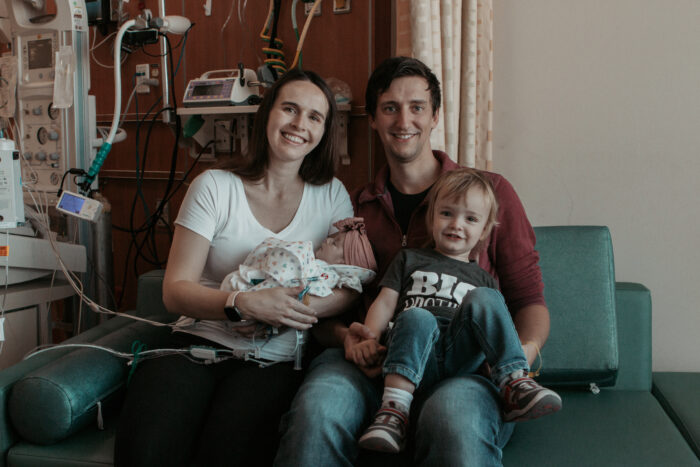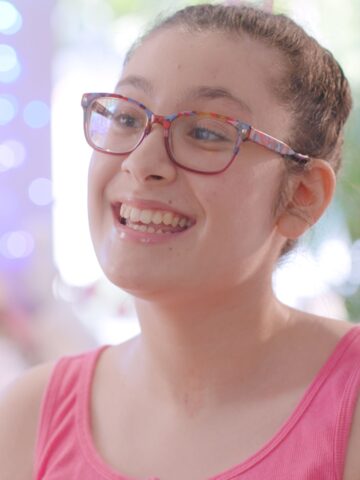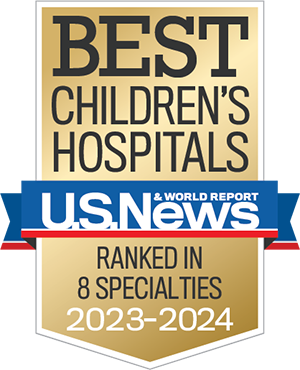Courtney Kline leans over her baby girl in the Pediatric Intensive Care Unit (PICU) and gives her a loving smile.
“Hey, baby,” she says to chubby-cheeked Emery.
A respiratory therapist (RT) monitors an air-filled vest that gently shakes Emery to loosen up her congested lungs. She’s too weak to cough up fluids, which the RT suctions out of her mouth.
On Mother’s Day, Emery caught a common cold that quickly progressed to pneumonia. Emery momentarily stopped breathing and Courtney rushed her to Rady Children’s Emergency Department, where she stopped breathing again. After about 20 seconds, she resumed breathing on her own.
“That was my Mother’s Day gift,” Courtney recalls.
A race against time
Pneumonia is bad enough, but for Emery, even a common cold could cause a severe decompensation, leading to death.
Born with an extremely rare and devastating type of mitochondrial disorder, she’s unable to effectively process food into energy. Instead, her body creates lactic acid, which at elevated levels can be extremely harmful to her body.

At birth, Emery’s lactic acid level was 20 times above normal and, with the help of the Metabolic specialist team, her lactic acid has improved dramatically. Still, she remains very fragile and is at a constant risk of metabolic crisis. Every organ is affected.
There are less than 100 children reported with FBXL4 gene defects worldwide like Emery. The defect causes her cells to have too few mitochondria and makes it challenging to support organ function and sustain life. There is no known effective treatment.
Metabolic specialists have managed to keep her alive to her first birthday with a specialized diet that helps reduce lactic acid levels but requires frequent blood draw to adjust nutritional content. She is also on experimental medications and supplements.
Courtney and her husband, Kevin, know they’re in a race against time and tirelessly advocate for more research to develop more effective therapies.
They both agree Rady Children’s is Emery’s best shot at survival.
Patient No. 5
Home to one of the few mitochondrial metabolic research labs in the country and staffed by a highly-specialized metabolic team (physicians, nurse practitioners, dieticians, nurses, genetic counselors, and a research team), Rady Children’s is a hub for metabolic rare diseases, a program launched by globally recognized metabolic disorder expert Dr. Jose Abdenur.
“If we did not already live in Orange County, we’d likely be flying across the country to seek treatment here,” Kevin says.
Despite the rarity of the disease worldwide, Emery is the fifth patient Rady Children’s has treated for the FBXL4 gene defect.
Even with all the expertise, the team is challenged with Emery’s disease complexity and are collaborating with researchers around the world to find the best treatment options for her.

Most kids like Emery have a life expectancy of less than two years. As a newborn she was a far more severe case than Rady Children’s other FBXL4 patients. She has challenged the team to push the boundary of treatment further and to lean on cutting-edge research, most of which has only started to come out in the last few months.
Despite the reality that Emery is on the more severe end of the spectrum for an already devastating disease, Courtney and Kevin, who have a healthy 3-year-old son, Weston, are clinging to hope.
“We know she’s being treated at the best place possible,” Courtney says, “but we also know, realistically, that she probably only has a few months as opposed to years.
“But we’re going to keep going — not just for her anymore, but for her legacy.”
Courtney gazes at her daughter.
“We’re in the ultimate rush, right baby?” she says.
Loving brother
Most healthy 1-year-olds are standing up with some support and maybe even walking.
Most are eating solid foods and saying “dada” and “momma.”
Emery can’t sit or even hold her head up.
She can move her arms and legs but not in a very controlled manner.

She has poor vision but can sense light.
She appears to respond to her parents’ voices.
Sometimes, she smiles.
Emery receives all her food and medications through a gastrostomy tube and relies on CPAP (continuous positive airway pressure) and occasional oxygen while sleeping.
Neurologically, Emery is at the level of a 1-month-old, her parents say.
Like she does with Weston, Emery’s brother, Courtney reads and sings to Emery and cuddles her. Emery makes sweet coos.
“She loves to be held,” Courtney says.
Her brother, always looking out for her, sets her toys and blankets next to her.
“It’s really sweet watching him with her,” Kevin says.
Says Courtney: “Weston is the only person who doesn’t look at her and see a sick child. In his eyes, there’s nothing wrong with her. She’s just Baby Emery.”
A quick diagnosis
Rady Children’s doctors figured out what was wrong with Emery five days after she was born.
They were able to rule out infection or heart issues – the usual culprits for Emery’s significantly high levels of lactic acid shortly after birth, says metabolic disorder specialist Dr. Richard Chang, assistant division chief of metabolic disorders and the doctor who’s in charge of Emery’s day-to-day clinical care.
The hunt was on for a diagnosis.
It came after Dr. Chang sent samples of Emery’s blood to Rady Children’s Institute for Genomic Medicine (RCIGM) for Ultra-Rapid Whole Genome Sequencing. Founded in 2014 at Rady Children’s Hospital San Diego, RCIGM has pioneered rapid genome sequencing including setting the world record for the fastest genome sequencing and continuing to have one of the fastest clinical genome sequencing tests on the market.
In January 2025, CHOC and Rady Children’s Hospital united under a combined parent organization, Rady Children’s Health.
“Rapid genomic sequencing is essential in this population of critically ill children and babies,” said Jerica Lenberg, MS, CGC, lead, licensed certified genetic counselor, at RCIGM. “If there is a treatable genetic disorder, the earlier the diagnosis is made the better chance for improved outcomes. A quick answer can be the difference between life and death in some cases.
“Even when testing finds a diagnosis without a treatment, or is non-diagnostic, the results often impact care decisions for the providers and the family,” Jerica added. “For Emery, an accurate diagnosis gave her family and medical team the precise underlying cause for her symptoms, guided supportive therapies, and has opened the door for further research toward identifying treatments.”
Time in the NICU
Emery spent her first 10 weeks at the neonatal intensive care unit (NICU). Courtney describes the quality of care as exceptional.
“It was unlike any healthcare I have previously experienced,” she says. “The nurses were attentive and fierce advocates for our baby. The doctors dedicated themselves to understanding every detail and ensured parents understood, too. We were encouraged to collaborate with Emery’s entire care team.”
The list of Rady Children’s specialists who have treated or continue to treat Emery totals 13, from doctors in primary care to gastroenterology to ophthalmology.
Her parents carry a printed list of diagnoses to show doctors whenever Emery is rushed to the Emergency Department – too many for any parent to recite from memory.
Courtney notes that many families never get a diagnosis and some rare disorders aren’t being studied (if at all) to the extent that her daughter’s condition is.
For that, she and Kevin are immensely grateful.
“Emery’s a perfect example of why pediatric hospitals should be focused on research. If a hospital is not willing to be cutting-edge, we lose these precious babies,” Courtney says.
Jobs brought Courtney and Kevin to Orange County from across the country before Emery was born.
That fortunate twist of fate isn’t lost on them.
“It cannot be a coincidence that we were called to leave our friends and family only to land in a center of excellence for our daughter’s rare disease,” Courtney says.
Rare disease advocates
Emery’s health odyssey has motivated the Klines to personally learn the latest research and advocate to advance any findings with potential to impact Emery’s trajectory, especially if they may become available during her lifetime.
Dr. Abdenur, director of the Laboratory for Energy Metabolism (E-Lab) at Rady Children’s, fully recognizes the time constraints and has been very active in Emery’s case. He frequently discusses new research publications with Kevin and Courtney and has been very willing to pursue experimental treatments. His lab has samples of Emery’s skin cells and world-class capabilities to confirm the safety of experimental drugs prior to giving them to Emery.
Courtney and Kevin have started a Raise Up CHOC Foundation page in their daughter’s name. Funds from this effort go to Rady Children’s E-Lab. For Emery’s first birthday, they sent an email thanking all their friends and family who contributed, specifically citing that the experimental drugs identified in the lab are likely the only reason why Emery made it to her first birthday but also noted that more work remains to be done.
Courtney and Kevin also created a website to increase awareness of Emery’s rare diagnosis, allowing friends, family, and strangers to follow Emery’s journey and fund research.
Courtney has become a layperson expert on her daughter’s disorder, reaching out to parents of other kids with the FBXL4 gene defect to offer support and share information.
“I’ve spoken to families in Brazil, Norway, Japan, China, India and other countries, and to metabolic researchers in Australia and the United Kingdom,” she notes.
Dr. Chang follows Emery every two to four weeks for blood checks, medication, and dietary adjustments, coordinating her care with the rest of the metabolic team and Dr. Maija-Riikka Steenari, Emery’s neurologist.
“One day there will be a child with FBXL4 whose life, due to scientific advancements, takes a new trajectory,” Courtney notes.
Until then, she and Kevin keep pressing on – clinging to hope in the most trying of situations.
“When faced with losing a child,” Courtney says, “parents will do anything.”
Learn more about metabolic rare disease research at CHOC




